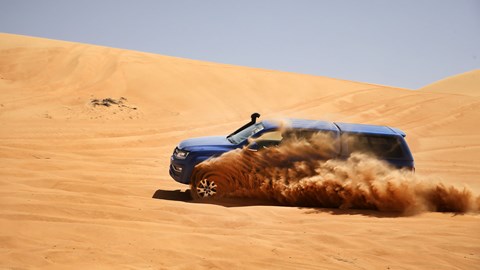► VW launches new, more powerful Amarok
► On and off-road adventure drive in Oman
► 428lb ft knockout blow to Merc X-Class?
Sand dunes stretch as far as the eye can see, like a golden sea frozen in a heavy chop. Welcome to the desert. Welcome to Oman.
The sun is setting, which is at once beautiful and slightly concerning, as not two hours ago we were told unequivocally that we must be down off the dunes before it gets dark, and there are currently seven or eight Volkswagen Amaroks parked on a sort of plateau just below the crest of the one I’m standing on.
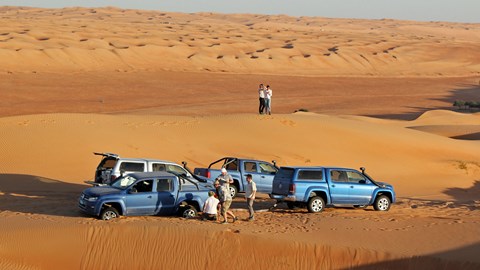
I say parked; at least 50% of them are in fact actually stuck, in some cases up to the sills. The sound of increasingly stressed German floats on the gentle breeze, soundtracking the so far unsuccessful attempts to free them. The spectacle has diverted the attention of an amorous couple who had clearly scaled the dusty peaks with the intention of watching the sunset – though surely not even modern romance involves Teutonic swearing and immobilised pick-up trucks, it’s difficult not to find the whole thing rather amusing.
Although that’s perhaps largely because I know that our accommodation for the evening is only hidden out of sight by the tallest dune in front of us, a mere five minute walk/tumble away, should the sand remain unyielding.
It is presumably less amusing for the VW crew, who have brought a group of journalists all the way out to Oman as a means of demonstrating the Amarok’s capabilities beyond those typically associated with builders yards and lifestyle posturing. Having a bunch of them get stranded overnight within minutes of the first paltry attempts at dune bashing most definitely wasn’t part of the plan.
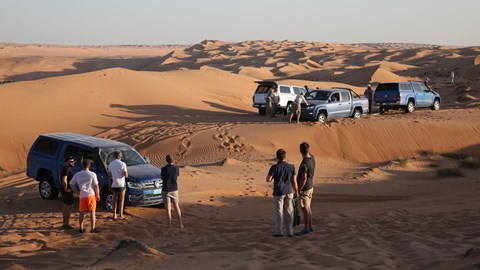
But from my perspective, safe in the knowledge that the 1000 Nights desert camp – which is basically a hotel where the rooms have canvas ceilings, before you get too carried away – is just over the gritty horizon, the Amaroks’ apparent frailty in the face of this particular challenge has come as something of a relief.
Because up until this point VW’s posh pick-up was looking so damn accomplished, I was worried I’d be writing little more than an advertorial for the Omani tourist board here.
Premium pick-ups are now definitely a thing
This whole situation is Mercedes’ fault, of course. If it hadn’t decided that what its light commercial vehicle range really needed to polish it off was a rival pick-up – the X-Class – Volkswagen probably wouldn’t have felt the need to remind everyone that it was already building the closest thing you can get to a premium trucking experience by organising this Middle Eastern expedition.
Not that I’m complaining. For all that it’s an absolute monarchy with a slightly wonky reputation in the area of human rights, Oman is a spectacular country – and this three-day adventure swiftly proceeds from the sprawling modern metropolis of Muscat to the desert and back, via the Gulf of Oman coastline and the Al Hajar mountains, the highest in the region.
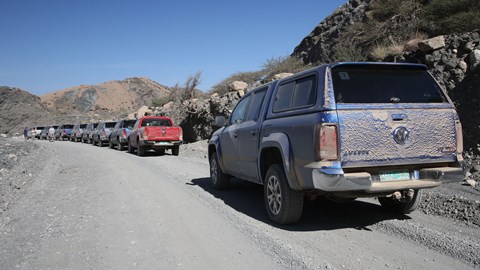
The Germanic butting of heads particularly concerns the use of 3.0-litre V6 engines. The entire UK Amarok line-up upsized from four-bangers to V6 power in late 2016, topped by a 221bhp model capable of 0-62mph in 8.0sec.
The X-Class then arrived in 2017 with the promise of an even more powerful 255bhp V6 – although this couldn’t quite distract most interested parties from the reality that Mercedes’ pick-up was a Nissan Navara in disguise, and at the moment is still only available to buy with the Japanese manufacturer’s four-cylinder units.
Mercedes might have gotten away with the power advantage if hadn’t also started telling the world that the X-Class was the first truly premium pick-up. Which I suspect rather got up VW’s nose.
’Kind of a pissing contest’
As such, later in 2017 Volkswagen revealed a 255bhp Amarok ‘concept’ of its own, and blow me down with a feather if it there isn’t a trio of engineering prototypes for the production version of this very model waiting for us when we step off the plane from Heathrow.
In other words, VW has rather neatly managed to get us behind the wheel of its latest, maddest and baddest V6 pick-up – which hasn’t really been officially confirmed up until this very point – while Mercedes is still merely bragging about its singular V6 variant no-one has yet been able to drive.

What’s more, just to ram VW’s market position home, not only are there are multiple examples of the entire four-part Amarok V6 range – including the entry-level 161bhp version – surrounding the three 255bhp models in Muscat airport car park, it turns out the new version overboosts up to 268bhp when required. Eat that, Mercedes.
VW Commercial Vehicles comms boss Andreas Gottwald candidly admits this is indeed ‘kind of a pissing contest.’ But if that’s the case, it’s one that Volkswagen appears to be winning – at least until Mercedes gets around to revealing the hinted-at X-Class AMG variant.
And even then VW may still have the advantage when it comes to the all-important – in pick-up terms – matter of torque. This new 255bhp Amarok glories in 428lb ft of the muscular stuff, whereas the X-Class’s Navara underpinnings limit its 255bhp V6 to 406lb ft, a figure already available to owners of the existing 221bhp Volkswagen.
VW Amaork: a pick-up that does comfort properly
Mercedes has a point about being the more premium brand, of course. But after a fitful overnight flight where sleep refused to come, followed by a lengthy period of visa processing and a half-hour briefing outside in the blazing Omani sun, stepping into the air-conditioned balm of the Amarok’s interior is very much on point for an oasis of calm cliché.
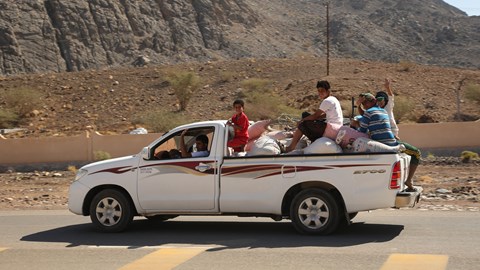
Some people still complain that the Amarok’s interior plastics don’t live up to the promise of the VW name. But all I see is sensible, reassuring design that dodges being dull by virtue of its crispness, well laid-out controls (something almost every other pick-up struggles with), and an infotainment system that, simply, works.
So what if everything feels a bit harder than the stuff you find in a Golf? This is, at heart, a working vehicle, and if VW has placed being tough above fingertip squish, so be it. Much more critically for the lengthy journey ahead of us, the seats are excellent and the driving position thoroughly adaptable (the X-Class’s Navara underpinning have left it short of reach-adjustable steering, for goodness sake).
We’ve snagged a 255bhp prototype for the first section, like all the others here fully kitted out with off-road underside protection and a snorkel (for the dust and not just the looks, presumably). Convoying out of Muscat into the countryside – a process that takes well over an hour of motorway driving, such is Muscat’s sprawl and keenness for speed cameras – the other immediate advantage the Amarok displays over its rivals is a welcome abundance of ride comfort.
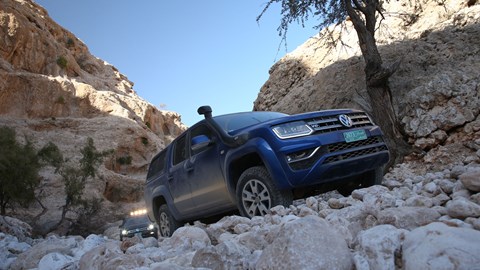
Pick-ups are not typically very good at this. At all. I promise I will stop mildly bashing the Mercedes in a minute, but having driven the X-Class in the UK recently, it’s clear this gets its handling supremacy at least in part from an exceedingly stiff suspension setup. Fillings will be rattled, frequently.
The VW simply soaks everything up – with only really major surface damage getting through to shock the ladder-frame chassis and the occupants in the body on top. And that’s despite being fitted with rear leaf springs, rather than the new-fangled coils (as used on cars for decades) the most sophisticated competitors (…) now employ.
Oman: public relations by geology
The Amarok’s steering is slower, and the body control has more slop. But never to the point where it’s excessive, and the whole vehicle is so in sync that you quickly stop noticing this from within the wash of its wider talents. The comfort is so supreme – who’d have thought a pick-up would be this suitable for literally crossing a country?
The engine, essentially the same as that fitted in Audis (the Amarok representing the cheapest way to get it in the entire VW Group, I’m told), surges effortlessly up the increasingly impressive inclines of Oman’s mountain highways, the standard-fit eight-speed automatic smoothly managing the torque, the snorkel making marvellous sucking noises. Slurp.
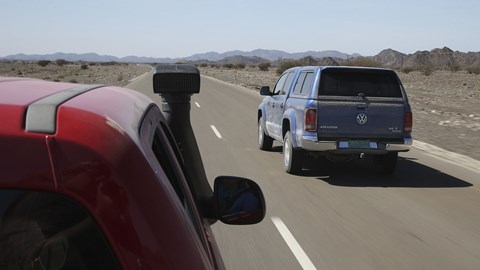
Things get a bit more brutal if you stamp on the accelerator – which I confess I occasionally do, just to relieve the unavoidable motorway monotony as we cruise control towards the Omani coast – gears thumping home rather than slinkily shuffling. But about the only engineering parts on these test cars that aren’t production ready are the engine mounts; the harder final pieces may resolve this.
The day progresses, and the geological department of the Omani tourist board begins its charm assault. We stop first at a millennia-old sinkhole that tourists and locals enjoy as a swimming pool, then a beautifully sandy beach abutting the Gulf of Oman, all accessed by near pristine tarmac. The weather is hot, the vistas largely uninterrupted.
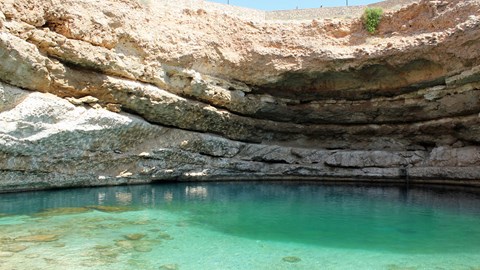
There are camels, wild donkeys, a second sinkhole – or is it a cave? Whichever, this is one of the largest natural chambers in the world, so big that the mentally-detached Felix Baumgartner successfully base-jumped into it in 2007. It’s nearly enough to distract this pathetic western traveller from the reality of the available toilet facilities.
Beehive tombs and the Total Perspective Vortex
The going begins to get tougher as we head back into the mountains towards our first overnight stop. The road disintegrates into gravel at times, which doesn’t seem to bother the locals much as they almost exclusively drive Toyota 4x4s – a boxy Land Cruiser pick-up in particular. They wait patiently, and generously, for our convoy to pass whenever the passage is too narrow for two-way travel.
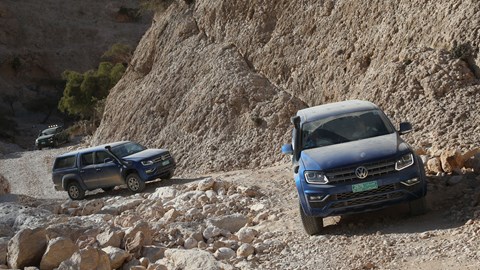
On more aggressively clambering hairpin slopes the potential for traction issues has been resolved by the generous application of cement, poured on thick like some kind of Nardo Grey ice cream topping.
Upgraded with the optional rear limited-slip diff, the permanent four-wheel drive of our 255bhp Amarok storms these slopes regardless, grippy and assured and urgent. Ruts, big torque and those rear leaf springs occasionally deliver some moderate axle tramp, but the sensation of all-conquering ease abounds. The VWs are making very light work of this.
They’re yet humbled by the environment, however. As we approach the plateau where we’re to spend the night, eerie stone structures begin to appear around us, painstaking assembled from stacked but unsecured rocks. These are Oman’s ancient beehive tombs – some collapsed but many intact, they’re said to date from the third millennium BC. Which rather puts our little escapade here into perspective.
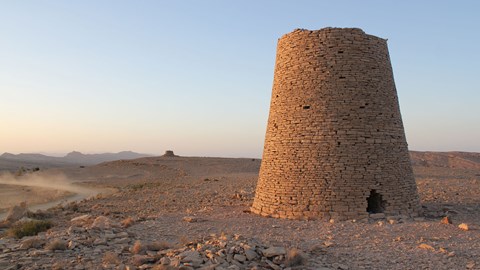
Dinner is a barbeque by LED floodlight – the only artificial illumination for miles around, this singularly fails to mask the astonishingly vivid starscape above us, which (because I can never resist a Hitchhiker’s Guide reference) seems to function as nature’s very own Total Perspective Vortex machine.
Bed is a sleeping bag. In a pop-up tent. On a rock. For all that it’s becoming clear the Amarok is more accomplished at this sort of thing than I am, having been awake for something in the region of 40 hours at this point, dreams come easily, and I sleep so hard I don’t remember them in the morning.
Beware rain in the desert
Day two dawns, hazily at first, and we’re off down the other side of the mountains towards the interior of Oman and – eventually – the desert.
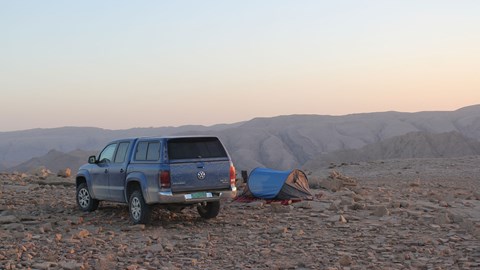
The geology shifts abruptly: rocks darkening from a sandy grey to near black. We pass massive slabs of landscape that seem to have been stabbed diagonally into the atmosphere and snapped off; other sections that have been folded back on themselves repeatedly like filo pastry. It’s breath-taking.
Complex irrigation systems provide green relief on a regular basis – which seems untenable when we stop for an hour or so to play with the Amaroks in a dried-up river bed.
Known as wadis, these are a constant geographical feature of Oman, and it’s hard not to notice how the roads that cross the plains beneath the mountains are either built-up above them or feature brightly coloured poles on either side – like the road markers you find in snow-heavy Scandinavian countries.
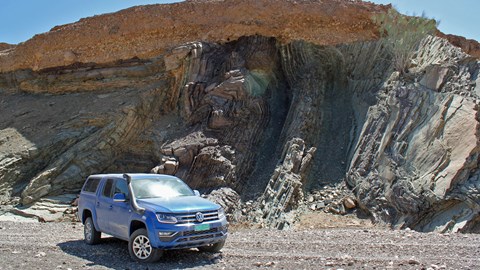
Turns out that when it rains over the mountains, the fall water gets flushed down into the valleys below with such force that flash floods come quickly, and deadly. With cars and houses being washed away, the threat to life is so severe the Omani government is working on an early warning system.
Perhaps the Amaroks’ snorkels aren’t for dust after all. Cue suspicious upwards glances, and relief at the unrelenting sunshine. Temperatures scorch towards 40 degrees. The Volkswagens stroll unflinching onwards.
The not so Empty Quarter
We stop for fuel after lunch. You don’t want to run out in the desert. The 43 litres it takes to top-out the tank in our Amarok costs 10.20 Omani Rial. Which is £18.67. Gulf States, eh?
I’m not sure what I was expecting, but when we finally reach the desert, the transition is strangely… abrupt. One minute we’re in a town – where we stop at a garage that’s geared-up to quickly adjust tyre pressures on mass – next we’re at the edge of town, and then immediately on the sand. Which is golden and smooth-looking, but somehow also ominous.
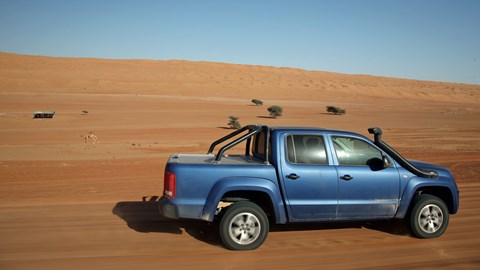
The advice from our local guide is straightforward: keep a decent space between vehicles and keep a decent pace up. As when driving on snow, controlling momentum is everything – which sometimes means applying plenty of power on approach to a slope.
This first section is well-travelled – essentially a desert road as wide as the M25 – and with the added footprint of the lowered tyre pressures, once again the permanent four-wheel drive and automatic transmission combination are decidedly unfazed. The sand stretches out ahead of us, quietly bristling with challenge. A Toyota towing another (broken) Toyota passes us going the other way.
For all that this area is part of the Empty Quarter, there are plenty of signs of civilisation on route – ranging from camel enclosures and modest dwellings to the less salubrious sight of discarded water bottles and shredded car body panels. Ciphers and consequences of disrespect.
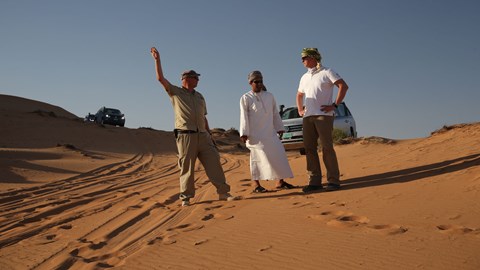
The endlessness of the scenery makes it difficult to keep track of time, but after a reasonably substantial chunk of it the 1000 Nights camp appears before us. There’s no opportunity to check in, though, as the Germans are keen to go and play in the dunes before we lose the light. The guides appear to consider this somewhat dubiously for a moment, before agreeing to lead us in the opposite direction.
Shortly after this, the Amaroks are stuck, and I’m watching the sun set over the desert.
So, how exactly did all the Amaroks get stuck in the desert?
Don’t get me wrong. The VW Amarok is a capable off-roader for a vehicle of its type, and even if we were travelling in more extreme machines, dune bashing is tricky enough that you’d expect to occasionally have to dig yourself out.
But as dusk approaches and there are still several VWs stranded, it’s possible there’s been a slight breakdown in organisational good sense here.
Gottwald can be heard proclaiming ‘It’s never the vehicle, it’s always the driver!’ And to a certain extent he’s right – I’ve only had the pleasure of watching so far, and it’s obvious from where I’m standing that people aren’t clearing the top of the slope properly when they do make it up the dune, which is in turn causing the next truck to get stuck because there’s no-where for them to go.
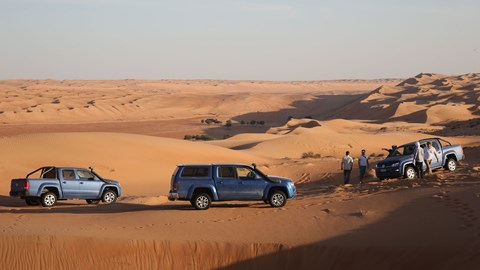
But equally, the initial route chosen was rather challenging. I’m sat in the passenger seat with a colleague who has done a lot of desert driving at the wheel; he makes three attempts only to find the Amarok sliding back sideways down the banked sand. Sliding sideways down sand is little but luck away from rolling the vehicle. We get away with it. Thrice.
The Amarok also has a slight disadvantage in these conditions due to its relatively low ground clearance – which means it gets more stuck, more quickly, something that’s actually not helped by the additional underbody protection. This not only lowers the ground clearance further still, the plates are acting like sand anchors when the trucks dig in.
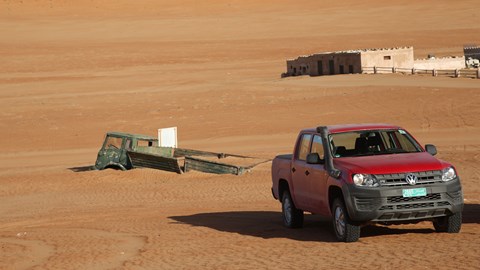
All thoughts of driving further are swiftly abandoned, and although it does take until after dark – which is of course the point at which I get one stuck – every one of the Amaroks gets back down to the camp under its own steam.
And they’ve survived the experience without damage. Which is more than you can say about day three.
Keeping the momentum up
The third and final day of our Omani Amarok adventure takes us further into the desert, for a spot of slightly more controlled dune bashing.
For this my driving partner and I have traded the 255bhp Amarok for one of the entry-level 161bhp versions. These are equipped with six-speed manual gearboxes, selectable rather than permanent four-wheel drive, smaller wheels, and BFGoodrich all-terrain tyres rather than the General Tire Grabbers fitted on the fancier models.
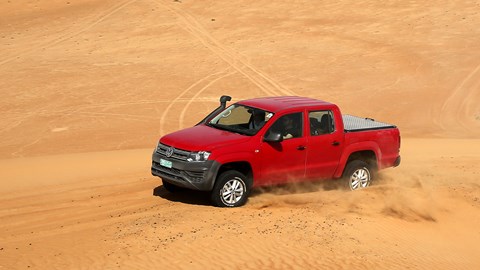
Driving it is surprisingly different, and more involved. Perhaps it’s the tyres, but it seems to skate more over the sand, and as we go faster and faster, steering it becomes closer to driving on ice – or even piloting a boat in water – as the shifting surface demands constant correction.
The ability to lock this pick-up into rear-wheel drive adds an extra dimension of entertainment. Although we’re instructed to shift into four-wheel drive at the first sight of rougher going, it’s clear that with enough speed in RWD this truck isn’t going to get stuck on the well-travelled desert paths we’re currently using. Seeing through the clouds of dust generated by the vehicles in front is a bigger problem.
Dune bashing – a beginner’s guide
All is sweetness and light until we have to traverse the first truly tricky, turning slope, and a ditch near the top sucks in not one but two of the Amaroks behind us. The bumpers and egos take the brunt of the damage, however, and since both vehicles were being driven by crew rather than journalists, the incident passes with minimal comment. Ho ho.
The low-speed crash structures seem to work pretty well, too. Overnight parts from Germany and both victims will be good as new. More or less.
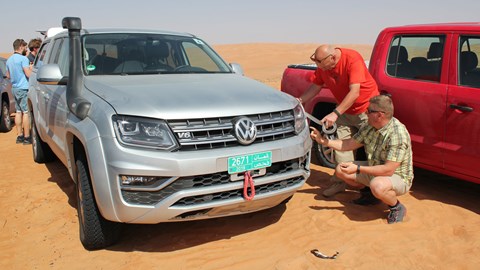
Compared to this, the actual dune bashing is a tidy affair. The scariest aspect by far is driving back down the steeply banked sand – you need to stay as straight as possible, for if the rear starts trying to overtake the front you’re flirting with a roll-over again.
But stick with first or second gear and the engine will do most of the braking for you, and within half an hour or so there are Amaroks taking increasingly tenacious routes to the top of the dune before plunging back down it at higher and higher velocities. The indignities of the evening before? Forgotten.
Home again, home again, with renewed respect
After a couple of hours it’s time to trek back out of the desert, towards Muscat and, eventually, Heathrow. After a stop to reinflate the tyres and a late lunch hosted by an Omani family in their home, the Amaroks’ last challenge turns out to be rush hour traffic, which they scythe through dusty and proud, the big VW badges drawing curious but not, you sense, unadmiring glances.
Three days ago, I would not have believed these pick-ups would make such a consummate job of this circular journey.
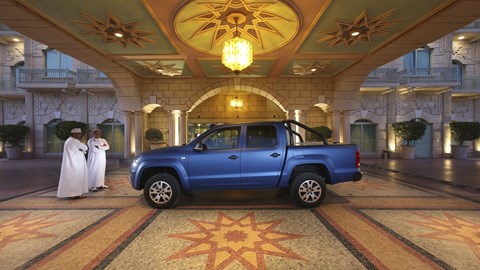
It’s not that we’ve covered hundreds of miles over mostly inhospitable terrain without major incident – I had expected that, though for there to be no punctures at all has renewed my respect for modern tyre technology, let me tell you. Rather, it’s the Amarok’s ability to do this without placing any real strain on its occupants that’s really surprised me.
From the light but accurate steering to the immensely impressive levels of comfort and the effortless V6 engines, the Amarok hasn’t just made this feel easy for a pick-up, it’s made it feel easy full stop. As we pull into the pre-flight hotel and prepare to hand back the keys, I find myself thinking it would be no hardship at all to do the whole thing all over again in one of these. Which coming from a pale-faced, office dwelling, anti-adventurer like me is true praise indeed.
